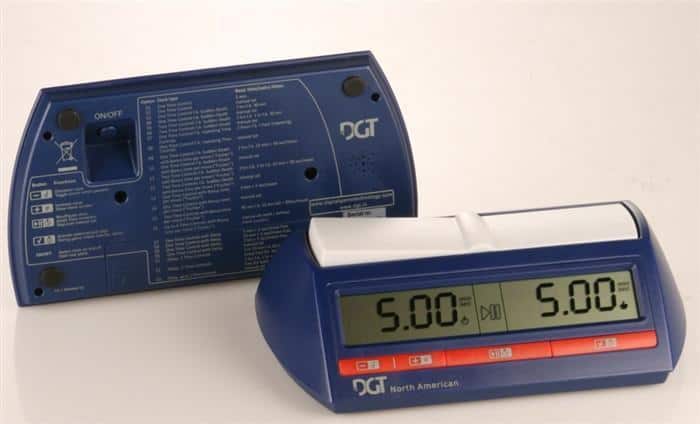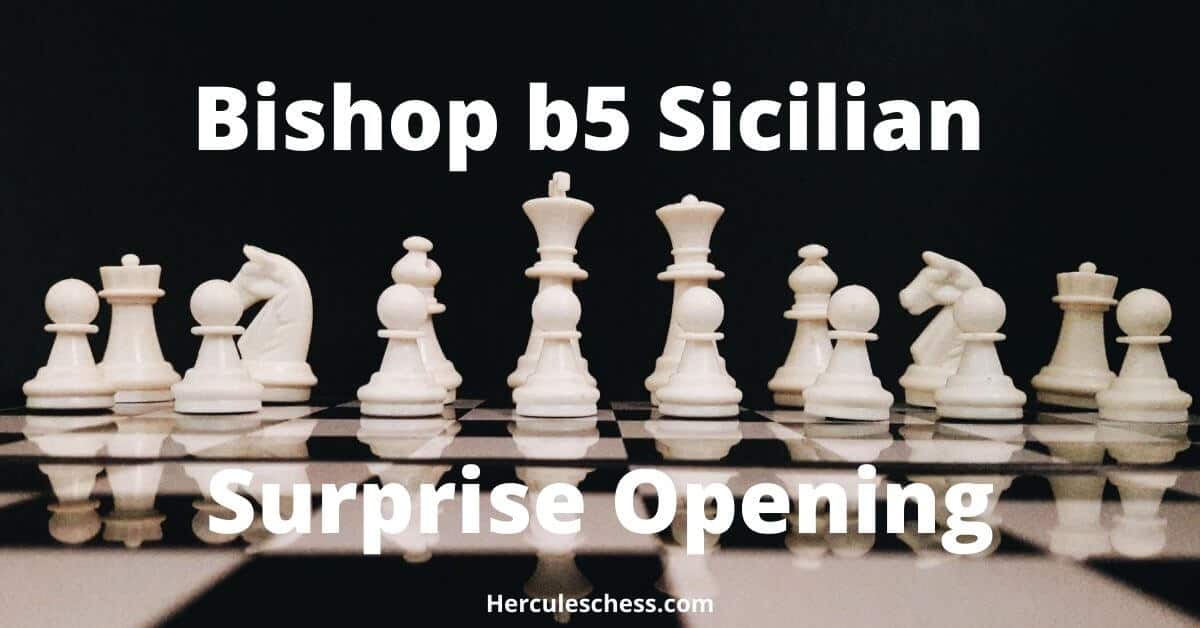This DGT North American Chess Clock has been designed to be used as a game clock for various two-person board games, especially Chess, Go and Draughts. This gaming device has several features which makes it an all-in-one digital clock and one of the best on the market. The features of DGT NA include:
- 10 different programmed functions covering all popular timing standards
- Additional manual programming functionality for all methods
- All 10 manual settings are stored in the clock’s memory
- 13 pre-programmed options for quick and ease of use
- Move counter for all options
- Time and move counter correction option during a game
- Optional sound alert to warn for running out of time
- Low battery indication
Get the NEW DGT North American while stocks last!
DGT North American Specifications
| Specifications | Description |
| Batteries | Two AA-size (alkaline recommended; current consumption 2 uA when off, 10 uA when on (battery life approx. 10 yrs.) |
| Accuracy | within 1 second per hour |
| Housing | ABS plastic |
| Display | 1’ x 5-3/8’ (inches) |
| Weight | 8.6 oz. (with 2-AA batteries installed) |
Click here to get DGT North American on Chesshouse.com
(Chesshouse.com is the most reliable and trustworthy store for buying chess related products. They are also known for their fast delivery of products from all over the world)
Timing Functions
Time forms a part of every sport, especially sports such as chess, go, draughts, shogi and Scrabble. The difference between the players is determined not only by the potential performance level of the individual players but also by the time a player needs in order to reach this level.
The more a sport is seen as a measure of performance, the more important it is to limit the time a player needs to make a move. This must be done in a way which is most appropriate for the game and the sport concerned. The DGT NA offers 10 different methods for the timing of a game between two players.
While several methods are well-known, others may be less familiar. Several of these methods have been in use for a long time; others are the result of the possibilities offered by modern electronics. Every method has its own charm and has an influence on the manner in which a sport is experienced.
The traditional “blitz” game of 5 minutes per person is different from 3 minutes using “Delay” or “Bonus” in which every move attracts an extra 3 seconds of thinking time, although the total thinking time for a game may not be much different. We recommend players experiment with the various methods which the DGT NA offers. It can add an extra dimension to your favorite sport. Below are the different time controls/functions of the DGT North American chess clock:
1. One Time Control – Rapid and Blitz Games
This is the simplest way to indicate time. Both players receive one period of time (i.e., there is a single time control with no Delay or Bonus time) in which they must make all moves.
2. One Time Control then Sudden Death
The first time control is used to play a predetermined number of moves. The secondtime control, the “Sudden Death” (or “Guillotine” as it is known in Europe) period, is used to complete the game.
One Time Control + Sudden Death is similar to “Rapid” and “Blitz” but usually with a slower start. Notice that the sudden death time is added for both players when one player has used all the time in the first time control (not after the completion of, e.g., 40 moves).
3. Two Time Controls then Sudden Death
For an even calmer start, it is possible to play a game with two time controls before the third time control, the Sudden Death period. Notice that the second and sudden death times are added when one player passes zero (0:00) time.
4. One Time Control then Repeating Time Controls
A quiet end to a game also has its advantages. The simple traditional (analogue) clock
gives the players repeated one-hour periods in which to complete a subsequent of moves. A digital clock can be set to any period of time for this repeating time control.
5. Bonus (“Fischer” or “Incremental” Mode) Options
The Bonus method (also referred to as a “Fischer” or “Incremental” Mode) is a timing system in which, for each separate move played- from the first move of the time control in question, bonus time is added to the available time. This method always gives the players the possibility of continuing a game, even when a great deal of time has been spent on earlier moves.
It is possible actually to obtain additional thinking time by completing a move in a time which is shorter than the extra time allowed. The total time increases with the bonus time that is not used. At the beginning of the game, the bonus time has already been added to the initial time period. In all Bonus options: When a player has used up all the time in the final time control, and no more time is added, the clock stops for both players and it is the end of the game. The freezing of the clock in this mode is according to FIDE regulations.
5a. One Time Control then Bonus (“Fischer”)
When the time displayed reaches 0:00 for one of the players, the second time controlbegins (the “bonus” period) and the time allotted for this second time control is added. The bonus time is added when this time control starts and after the completion of each move.
5b. Two Time Controls then Bonus (“Fischer”)
When the time displayed reaches 0:00 for one of the players, the second or third (the “bonus” period) time control (as the case may be) begins and the time allotted for the each such time control is added.
The bonus time is only added in the final time control. It is added when this time control starts and after the completion of each move.
5c. Bonus (“Fischer”) Single Time Control
One time control with bonus time. The bonus time is added to every move from the very outset of the game. When the clock starts, the bonus time is already added for the first move and will be added after the completion of each subsequent move.
5d. Bonus Tournament, up to 4 Time Controls with Bonus time per move (“Fischer”)
As far as the time for thinking is regulated, the bonus tournament method is the most complex. It features up to four time controls in which the bonus time is added for each move. When the time displayed reaches 0:00 during any time control except the last one, the next time control begins and the time allotted for the next time control is added.
The Bonus tournament, up to 4 Time Controls allows the programming of 4 different time controls, all with the same bonus time per move. For the first three time controls, a move number can be programmed. If the move number is set to a non-zero number, the time for the next time control is added when a player has finished the
programmed number of moves for that period. If the move number is programmed to 0 (zero), the transition to the next period takes place when a player’s display indicates 0.00.
If a player does not finish the programmed (non-zero) number of moves for a particular time control, when the display indicates 0:00, the blinking flag is shown and the DGT NA stops time counting for both players, indicating that the game has ended, with the player in question having lost the game on time.
For the correct working of the move counter driven Bonus Tournament option, the players are obliged to correctly stop the clock after each finished move, so that the clock keeps track of the played number of moves.
Always ensure that the lever is in the correct position and the player color icons are correct before a game begins.
6. Delay
Delay is a simple method to give each player a certain amount of extra time for every move. It is very common in American Swiss System tournaments. When a delay option is used, a player’s clock does not start running until the delay interval has passed. Thus, setting a countdown delay of five seconds allows five seconds to go by before a player’s clock begins to run.
For example, let’s assume a player has 18:37 of remaining time on the clock, and the game is being played with a 5-second delay. The opponent moves. When the opponent finishes the move by pressing the clock lever, instead of the display immediately beginning to tick down (18:36, 18:35, etc.), there is a five-second period called the delay just before the clock is activated. During the delay time, the word “delay” blinks in the display once per second.
When the delay time has passed the word “delay” stops blinking on the display and the clock starts counting down. As per USCF regulations, in delay mode, the clock will not show the blinking flag when a player has run out of time in the final period.
When the player with no time left stops his clock, the other player’s clock will resume counting down. This way it may be possible for both sides to end with zero time and a non-blinking flag.
Related Post: Time control for chess tournament
How to operate the DGT North American Clock
Batteries
The DGT NA requires 2 AA (penlight) batteries. We recommend low self-discharging alkaline batteries which may last many years of normal use. If you do not plan to use your timer for a long period, we recommend that you remove the batteries to avoid damage caused by possible leaking of the batteries.
If the Low Battery symbol appears on the timer display, the batteries need replacement. When this message first appears, the batteries still contain enough energy to allow the current game to be completed. In case of a malfunction, first remove, then reinsert the batteries.
Replacing the batteries:

- Remove the battery cover and the old batteries.
- Insert the new batteries with the “+” side pointing as in the drawing.
- Place back the battery cover.
- Dispose of the old battery as prescribed in your country or region.
Turning on the DGT NA
Switch the timer on and off with the ON/OFF button on the bottom of the timer. The ON/OFF button is placed on the bottom, recessed to avoid unintentional resetting of the clock.
Choosing an Option Number
When you switch on the timer, the display initially shows the option that was last selected. Press the minus or plus button to cycle through the 23 options. After number 23 the display returns to 01. A numbered list of all options may be found on the bottom of the timer.
Activating an Option Number
When the option number you want appears on the display, select and activate it by pressing the check button. The display then shows the default starting time for that option. You can now begin your game.
Starting a Game
When you have selected an option with a pre-programmed setting, make sure that the lever is up for the player who will be white. The player color is indicated with the white/black king symbol on the display. Now start the game, and the timer, by pressing the pause/play button in the middle.
Starting the DGT NA at the beginning of the game with the proper player designated as white will keep an accurate record of the move numbers, something that may be especially important in the Bonus Tournament options.
Temporarily Stopping the Timer
During the course of a game you can temporarily stop the timer by quickly pressing the pause/play button. Restart the timer by pressing the same button again (pressing longer than 2 seconds starts the time correction procedure.
Audible Signal
The DGT NA can give audible signals near the end of a time control. When this function is on, it will give a short beep 10 seconds before every time control and also for each of the last 5 seconds of the time control. At the last second before time control, a full second beep sounds.
However, the audible signal is given only when the “sound on” icon is visible on the display. The sound function can be switched on or off by pressing the minus button while the clock is stopped. All the options have the sound off by default.
Time and Move Counter Correction
During a game you can change the time that is currently displayed. Hold the pause button for two seconds until the far left display digit starts blinking. Now the times of both players can be corrected, digit by digit. To change the blinking digit, press the minus or plus button. Press the check button to move to the next digit.
After the player’s time, the move counter can be corrected: decrease or increase by pressing the minus or plus button. When the value is correct, press the check button. Now press the pause/play to restart the timer to resume the countdown based on the corrected times.
Manual Settings
Each timing method has an option number to allow manual setting of all the method parameters. After selecting a manual option number (e.g., option 04 for Time + Sudden Death) the parameters for this method must be set, digit-by-digit.
First, the main time control for each player must be set. After this, a number of parameters follow, depending on the selected option. Change the currently blinking digit with the minus or plus button. When the desired digit appears, press the check button . This causes the next digit to start flashing. If you don’t want to change a digit, just press the check button.
When you have finished entering all the parameters the display will show the pause symbol > || and both players’ clock times. Now the clock can be started.
Display Symbols
In addition to the digits the timer’s display shows the following symbols:
 |
Indicates that the batteries must be changed. |
| bonus | Indicates that a Bonus period is active. |
| delay | Indicates that a Delay period is active. |
 |
The interim flag. Indicates that this player has first gone to the next time period.
Disappears after 5 minutes. |
 |
The (flashing) ultimate flag. Indicates a player who has run out of time. |
| Hrs (min) | Indicates that the times displayed are in hours and minutes. A colon separates the hour and minutes digits (for instance 1:45 or 0:25). |
| Min (sec) | Indicates that the times displayed are in hours and minutes.
Indicates that the times displayed are in minutes and seconds. A dot separates the minutes and seconds digits (for instance 17.55 or 4.06). |
| Sound on | Indicates that the sound function is active, and the clock will beep when approaching zero time. |
 |
Indicates that the clock is paused, either ready for the first start, or paused. |
 |
Indicates that the clock is running. |
 |
Indicates the player color. |
Time Display
With 20 minutes or more remaining, the DGT NA displays hours and minutes. The icons “hr s ” and “m i n” are visible. With less than 20 minutes remaining, the clock displays minutes and seconds, and the icons “min” and “sec ” are visible. The maximum displayable time is 9:59:59. Attempting to enter more time simply results in 9:59:59 being displayed.
Checking the Option Number
During a game, you may check the selected option number without interrupting any clock function. To do this, press the check button.
The Move Counter
The clock keeps track of the number of moves that have been completed. When starting a new game the move counter has the value 0 (zero). The move counter changes when the black player has completed a move.
Checking the Move Number
When the clock is running or paused, you may see the move number by pressing the button. The running clock is not interrupted by this action.
Quick Setting Using Auto Repeat
For fast operation, you can hold the , or buttons. After a second, they will repeat.
Adjusting the Time
If you make a time correction while using an option with multiple time periods, normally the clock will assume that the same period that was being used before the correction is still in effect. Bonus tournament however, offers the possibility to allot a number of moves for each time control. If the move numbers for each time control are programmed to a non-zero number then, during a time correction, the move number can be changed and the correct period is calculated from that point.
Manual Settings
Parameters are saved in every manual set option until you change them or the batteries are removed. If, after a manual set option, the game is ended and the same manual set option is selected again, the parameters from the previous setting are saved. If in a multiple time control setting, a period is programmed with zero period time, this period and the following periods are skipped during the game.
When a time control is programmed with a zero value for thinking time, no further parameters can be set for this and any subsequent time controls.
Care and Cleaning
Your DGT NA is a durable, well-made product. If you treat it with reasonable care it should give you years of trouble-free performance. To clean the clock, use only a slightly-moistened soft cloth. Do not use abrasive cleansers.
Warranty conditions
DGT guarantees that your digital chess clock complies with the highest quality standards. If your DGT North American, despite our care in choosing components and material, production and transport, nevertheless may show a defect during the first two years after purchase, you should contact the retailer who sold it to you.
For warranty coverage on your new DGT North American, you should present the warranty card together with proof of purchase. This condition of warranty is only valid if the DGT North American has been used in a reasonably prudent manner as it is intended to be used.
Final Verdict- Why you should you get DGT North American Chess Clock
The DGT North American chess clock is by far the most famous and used of any other chess clocks largely due to its good reputation of longevity, durability and ease of use.
This clock has been around for so many years now and the DGT family are constantly working to deliver top notch quality of its products by finding new and innovative ways to advance their efficiency through technology. So what are you waiting for? Grab the newest model off the best online chess store!
Click here to order yours today! (Limited Time ONLY)
Fast Delivery from chesshouse.com (The #1 online store for chess related products)








